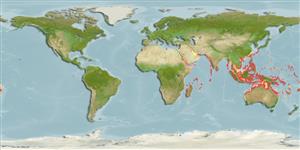Common names from other countries
Environment: milieu / climate zone / depth range / distribution range
Ecologia
marinhas associadas(os) a recifes; intervalo de profundidade 1 - 50 m (Ref. 11441), usually 1 - 15 m (Ref. 90102). Tropical; 30°N - 31°S, 30°E - 175°W
Indo-Pacific: Persian Gulf (Ref. 68964) and Red Sea south to Mozambique and east to Fiji, north to the Ryukyu and Bonin islands, south to New Caledonia. Recently recorded from Tonga (Ref. 53797).
Tamanho / Peso / Idade
Maturity: Lm ? range ? - ? cm
Max length : 8.0 cm TL macho/indeterminado; (Ref. 2334); common length : 6.0 cm SL macho/indeterminado; (Ref. 37816)
Espinhos dorsais (total) : 8; Raios dorsais (total) : 9; Espinhos anais: 2; Raios anais : 8. Bluish silver in color, with 6 orange-yellow stripes, including a short post ocular stripe. Sub-equal along abdomen, and midlateral stripe ends into pinkish to orange spot on caudal fin base (red at night) (Ref. 48635). Greatest depth of body 2.7-3.0 in SL (Ref. 90102).
Inhabits sheltered clear water areas of lagoon and seaward reefs from depths of 1 to at least 49 m. Found in small or large aggregations under ledges, in holes, or even among long spines of sea urchins. Feeds on planktonic crustaceans and small invertebrates. Has been reared in captivity (Ref. 35404).
Ciclo de vida ou comportamento de acasalamento
Maturities | Reprodução | Spawnings | Egg(s) | Fecundities | Larvas
Mouthbrooders (Ref. 240). Distinct pairing during courtship and spawning (Ref. 205).
Masuda, H., K. Amaoka, C. Araga, T. Uyeno and T. Yoshino, 1984. The fishes of the Japanese Archipelago. Vol. 1. Tokai University Press, Tokyo, Japan. 437 p. (text). (Ref. 559)
Status na Lista Vermelha da UICN (Ref. 130435)
CITES (Ref. 128078)
Not Evaluated
Ameaça para os humanos
Harmless
Uso pelos humanos
Pescarias: espécies comerciais; Aquário: Espécies comerciais
Ferramentas
Relatórios especiais
Baixar XML
Fontes da internet
Estimates based on models
Preferred temperature (Ref.
115969): 25 - 29.3, mean 28.4 (based on 3142 cells).
Índice de diversidade filogenética (Ref.
82804): PD
50 = 0.5000 [Uniqueness, from 0.5 = low to 2.0 = high].
Bayesian length-weight: a=0.01349 (0.00840 - 0.02167), b=3.13 (2.99 - 3.27), in cm Total Length, based on LWR estimates for this species & (Sub)family-body (Ref.
93245).
Nível Trófico (Ref.
69278): 3.6 ±0.56 se; based on food items.
Resiliência (Ref.
120179): Elevada, tempo mínimo de duplicação da população menor que 15 meses (K=2.93).
Fishing Vulnerability (Ref.
59153): Low vulnerability (10 of 100).
